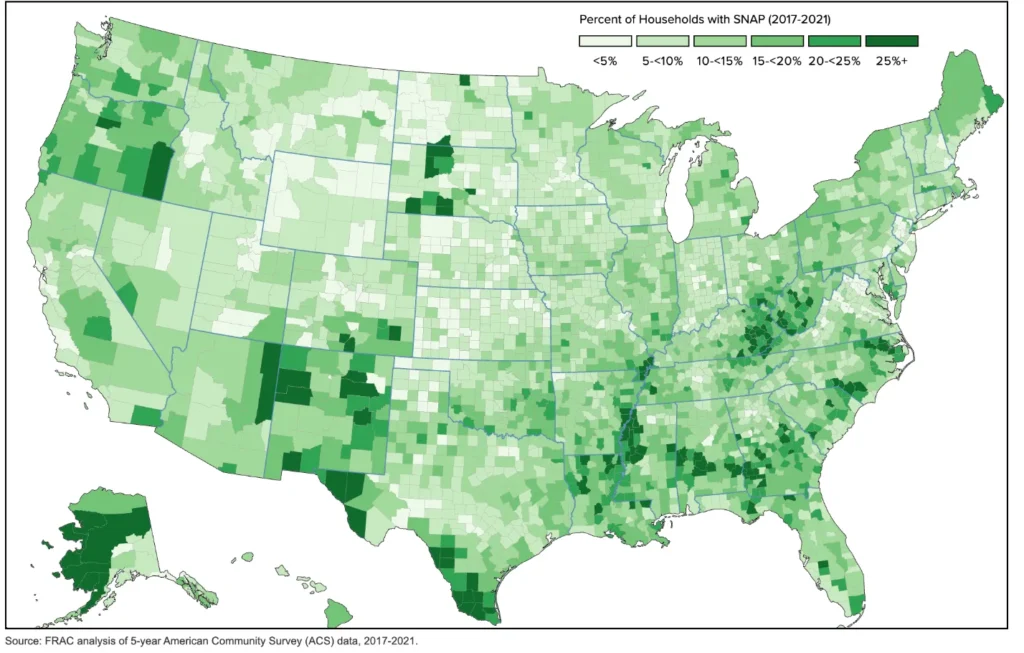THIS WEEK IN…
HUNGER IN AMERICA
In the richest country on earth, more than 40 million Americans rely on the federal Supplemental Nutrition Assistance Program (SNAP), the nation’s largest anti-hunger program, to be able to purchase food each month. For low-wage workers, the elderly, and people with disabilities experiencing food insecurity and hunger, the program provides desperately needed benefits for their families. Contrary to right-wing propaganda, most working-age recipients do in fact have a full-time job, but many companies, especially in the retail and fast-food industries, don’t pay their employees a living wage, forcing taxpayers and the government to subsidize their labor costs instead. With the government shutdown now in its fourth week, and the Republicans still unwilling to negotiate with Democrats on conditions for continued federal funding, 12% of Americans are facing the grim reality that their SNAP food benefits will run out on November 1.
In The Guardian, ERIC BERGER goes so far as to predict that Americans might face the greatest hunger catastrophe since the Great Depression.

CALLUM SUTHERLAND, writing for TIME, headlines his article: A Man-Made Disaster: Food Banks and Experts Issue Grave Warning as SNAP Benefits Set to Run Out Amid Government Shutdown.
The Guardian reporter MICHAEL SAINATO spoke with Katie Giede, a single mother from Conyers, Georgia, who, despite her job at a fast-food chain, depends on SNAP to feed her family. She worries that those who rely on the program are “already not eating enough, so we’re going to lose lives over this. It’s those of us at the bottom that are really feeling it.”
In his analysis The Hunger Games Begin, PAUL KRUGMAN outlines who will be hit hardest by the impending cut-off. Among SNAP recipients, “40 percent are children; 18 percent are elderly; 11 percent are disabled.” And like Katie Giede, “a majority of recipients who are capable of working do work. They are the working poor: their jobs just don’t pay enough, or offer sufficiently stable employment, to make ends meet without aid.”
The loss of SNAP funding will also have serious ripple effects on local economies, small businesses, and farmers. As ELENA PERRY, MONICA CARRILLO-CASAS, and THOMAS CLOUSE report in The Spokesman-Review, ‘A sad reality’: Food banks, grocery stores, residents expect to feel the strain from impending SNAP benefit expirations.

David Gilbert looks at how right-wing influencers use racist AI slop videos to spread falsehoods about SNAP recipients in No, SNAP Benefits Aren’t Mostly Used by Immigrants
There are potential stopgap solutions, such as using SNAP’s emergency contingency fund or exercising presidential transfer authority to continue payments even during the shutdown. But the administration and Republican politicians have rejected those options. SARAH FORTINSKY reports in The Hill that Speaker of the House Mike Johnson claims “contingency funds are not ‘legally available’ to cover benefits during the shutdown.”
Republicans have attempted to shift blame onto Democrats for refusing to “compromise,” but ERIC BERGER points out in The Guardian that this framing is misleading. “While Republicans have sought to blame Democrats for the potential loss in benefits that people who make little money rely on, those who work in the food-insecurity space say that is misleading because Donald Trump’s ‘One Big Beautiful Bill Act’ already eliminated almost $187 billion in funding for SNAP through 2034, according to a Congressional Budget Office estimate.”
The Trump administration also took steps to obscure the true scope of hunger in the United States. BETH SHAPIRO writes in her article America’s Hunger Crisis Is Growing. We’re Choosing to Look Away that “last month, the Trump Administration canceled the USDA’s annual Household Food Security Report—the only national data source that measures hunger by age, disability status, and household composition. For the first time in 30 years, America will no longer track hunger nationwide. Without that data, millions of older adults … will vanish from view as the social safety net continues to collapse around them.”

The troublesome truth is that the United States with over 10% of Americans living with food insecurity, has the sad record of ranking among the countries with the highest percentage in the industrialized world.
…IN OTHER NEWS
Since the start of the second Trump term, it has been ordinary citizens who have fought back against the administration’s actions. Once relied upon to uphold and defend democratic principles, the elite and numerous institutions have surrendered, rolled over and contributed to eroding fundamental rights and undermining the rule of law. In its place, Americans across the country have stepped forward and are not afraid to protest and exercise their rights, even at the risk of facing severe consequences. Many have paid a steep price for their defiance, facing violence, arrests, or even detention.
Demcast and Jennifer Canter met with “ordinary people in forgotten places” in: How Americans Are Blocking Trump’s Militia

“If convicted, people who showed up to a protest could face “decades of prison time”. Andrew Lee portrays attendees at a July 4th noise demo in Texas who are facing charges for “providing material support to terrorists” in These Dallas Residents Are on the Front Lines of Trump’s War Against “Antifa”
Continuing its weaponization of judicial power to crush dissent, the Trump administration has indicted progressive Democratic congressional candidate Kat Abughazaleh along with 5 other individuals for protesting near an ICE facility outside of Chicago report Lisa Rubin and Brandy Zadrozny.
How an innocuous Facebook post landed a man in jail. Liliana Segura on The Absurd Prosecution of a Man Who Posted a Charlie Kirk Meme. Larry Bushart had been jailed for more than a month. The charges were only dropped on Wednesday.
“While the media continues to ignore and even mock Trump’s war on “Antifa” terrorism as legally impossible, the FBI is quietly interrogating protesters” writes Ken Klippenstein. He tells the story of protesters who are being detained for exercising their First Amendment rights. Among them Chicago-based English professor Elias Cepeda who was arrested for speech federal authorities considered “pro-Antifa” and special-needs teacher Miles Serafini who was targeted and questioned by the FBI even though he had not been charged with any crime.

